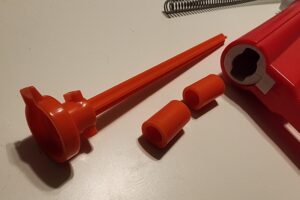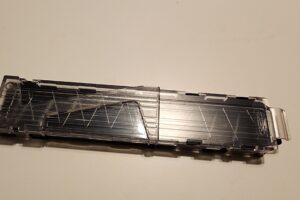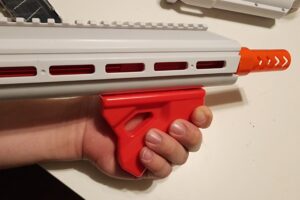

Gameface Trion
Velocity Outdoor
$80
130 to 200+ fps (based on stock spring and spacers)
Three darts per second (slamfire)
Competitive blasting on a budget, with minimal issues and room to customize.
Gameface Trion Review
March 1, 2023I’ve had the Gameface Trion for a while now. I’ve used it in semi-competitive games and casual settings like Humans v Zombies. And after all that use, I can confidently say that the Trion is perhaps the best use for $80 in this hobby.
Breaking Down the Blaster
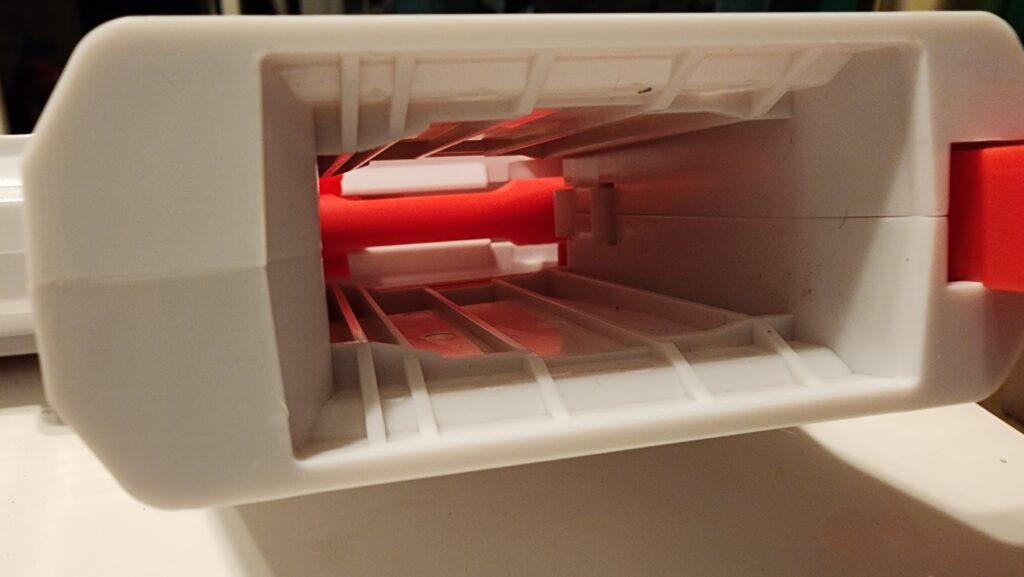 Let’s change the review format a bit. There’s a lot going on with the blaster, both on the outside and under the hood.
Let’s change the review format a bit. There’s a lot going on with the blaster, both on the outside and under the hood.
Inside the blaster, we have a LOT going on. First, there’s a nod toward backward compatibility; the Gameface Prime was, essentially, a Jet Ceda reskin, and used Katana magazines. The Trion uses new, Talon-compatible magazines, but maintains a dual-catch magazine well to allow the use of both. Katanas may be largely dead, but keeping compatibility with previous customers is a great move.
The blaster has several things that must be disassembled in order to peer inside. The grip comes apart, revealing a Picatinny rail underneath, and the grip/stock combo comes apart, too. Notably, this means you could replace the grip and stock with aftermarket parts from real-steel, airsoft, or other hobbies. Finally, a few clips have to be pried open.
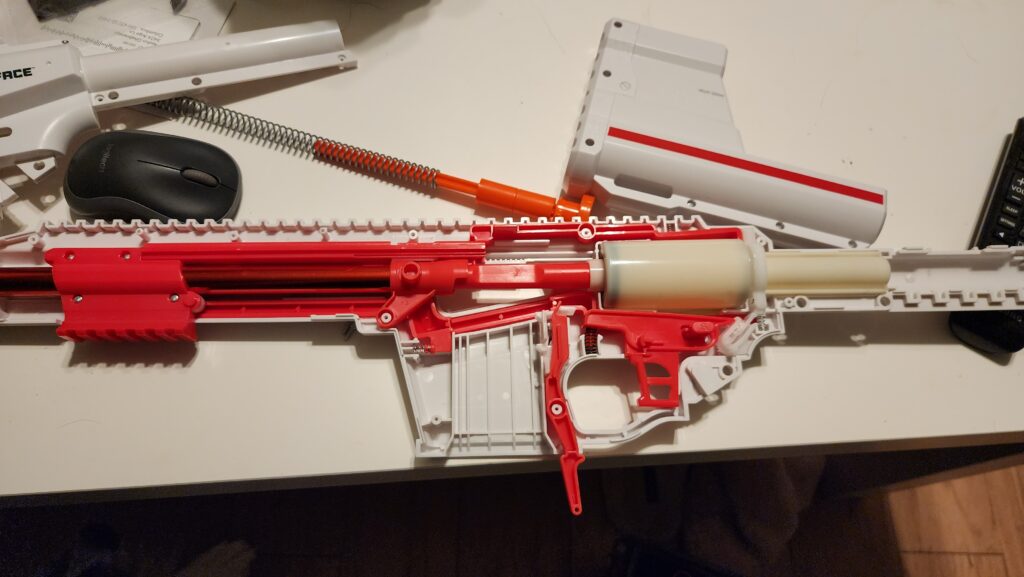 Underneath all that plastic lies the inner workings. A priming lock sits above the breech and plunger tube. A white dart guide sits within the priming sled, popping down against the darts in the magazine as needed. The rotating (NOT sliding) trigger interfaces the catch through a unique, slightly elastic plastic piece. Finally, a slamfire mechanism extends from the front of the blaster, through the top of the magazine well, to the catch, under everything else in the blaster. If you hold down the trigger, that plastic connector gets pushed against an indentation in the catch, while the slamfire bar holds the catch in place. Once you’ve primed the blaster and moved the handle forward, that bar moves out of the way, allowing the catch to be moved and the dart fired.
Underneath all that plastic lies the inner workings. A priming lock sits above the breech and plunger tube. A white dart guide sits within the priming sled, popping down against the darts in the magazine as needed. The rotating (NOT sliding) trigger interfaces the catch through a unique, slightly elastic plastic piece. Finally, a slamfire mechanism extends from the front of the blaster, through the top of the magazine well, to the catch, under everything else in the blaster. If you hold down the trigger, that plastic connector gets pushed against an indentation in the catch, while the slamfire bar holds the catch in place. Once you’ve primed the blaster and moved the handle forward, that bar moves out of the way, allowing the catch to be moved and the dart fired.
Compared to slamfire in typical Nerf blasters, it’s insanely simple. Hard to visualize, yes, but simple, and it requires far fewer moving parts.
The long, aluminum barrel sits up front and the priming grip sits over it. Roller bearings keep it aligned while smoothing out the priming motion. The Worker Harrier may feel amazing to prime, but the Trion is pretty close.
Using the Blaster
The Trion is simple to use. Prime the blaster with the pump handle, push it forward to lock, then pull the trigger to fire. Hold down the trigger to use slamfire. It can’t get much easier on the consumer!
Magazines can be inserted at any time, thanks to a skinny pusher in the breech.
The stock consists of two pieces – a white, movable section sits over the red stock/grip/thumbhole piece, and it can adjust to four different settings. Underneath that piece is how you access the spring and add spacers! The stock spring by itself shoots in the 130-140 range, while the spacers can bump it up incrementally to 200fps or more, depending on dart type (the included darts are lighter than DZ Max or AF Pro darts, for example, and will go faster out of the barrel).
The included magazine is really nice, much nicer than many other half-dart magazines, and it’s fully compatible with Talon-based blasters and adapters. The format works, so why not use it?
The priming grip does have a bit of wiggle from side to side. Even so, it’s nothing I find annoying or hampering; others may disagree.
There’s plenty of Picatinny rail for accessories, should you choose. The blaster does come with iron sight attachments!
Performance
In testing, both at home and on the field, I was able to get up to three darts per second with slamfire, even with both spacers installed. In fact, out of all the times I’ve used the Trion, I only recall one jam – and that was in an HvZ game, with an alternative spring and a mistake in operation! That it works so smoothly at a high rate of fire is a testament to the build.
The stock spring, depending on the compression load of installed spacers, can hit anywhere from 130fps to above 200fps. There’s variance between dart types, with the 1g darts leaving the barrel slower than the included “Chevron” darts (and DZP 2.0 darts, as well). But in general, the Trion can fit a wide range of game types. If you’re willing to experiment, more options open up. In my case, a Midwest Fastener SRM180 compression spring (0.5″ x 10.5″) with two spring spacers made for consistent 110-120fps shots for Humans v Zombies. (Find at Menards in the Midwest, or search online for 6-packs for your club).
Gameplay
I’ve been nothing short of happy with the Trion. I’ve only had one jam (due to user error), and the blaster shot well at all velocities. Granted, if you’re firing darts near 200fps, you’re reaching the limits of how much power the blaster can harness. Excess pressurized air coming our from behind the dart can knock it off course at that point, but it’s easy to buy SCAR barrels online, or to search for the files to print your own. Those will help keep the dart centered while the backblast dissipates.
Have some footage of me using the Trion, both in a high fps game in Maryland and in an HvZ game at Ohio University (watch the second half)!
Final Opinion
It’s hard to express just how good the Trion is for a price of just $80. It’s a blaster made by hobbyists for hobbyists, and it shows, both in the user experience and in the features and customization options present. I’m not sure how the Trion could ever be a BAD option for hobby grade dart blasting.
If you haven’t grabbed one, you’re missing out. This one is a perfect 10, in my opinion.
